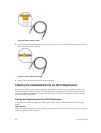
4
Back-End Cabling and Connecting Power
Back-end cabling refers to the connections between the storage system and expansion enclosures. After
the back-end cabling is complete, connect power cables to the storage system components and turn on
the hardware.
An SCv2000/SCv2020 storage system can be deployed with or without expansion enclosures.
• When an SCv2000/SCv2020 is deployed without expansion enclosures, the storage controllers must
be interconnected using SAS cables. This connection enables SAS path redundancy between the
storage controllers and the internal disks.
• When an SCv2000/SCv2020 is deployed with expansion enclosures, the expansion enclosures
connect to the SAS ports on the storage controllers.
SC100/SC120 Expansion Enclosure Cabling Guidelines
You can connect multiple SC100/SC120 expansion enclosures to an SCv2000/SCv2020 by cabling the
expansion enclosures in series.
The connection between a storage system and the expansion enclosures is referred to as a SAS chain. A
SAS chain is made up of two paths, which are referred to as the A side and B side. Each side of the SAS
chain starts at the initiator only SAS port on one storage controller and ends at the initiator/target SAS
port the other storage controller.
SAS Redundancy
Use redundant SAS cabling to make sure that an unavailable IO port or storage controller does not cause
a Storage Center outage.
If an IO port or storage controller becomes unavailable, the Storage Center IO moves to the redundant
path.
SAS Port Types
There are two types of back-end SAS ports on each storage controller: initiator only and initiator/target.
The ports labeled A are initiator only ports and the ports labeled B are initiator/target ports.
Figure 57. SCv2000/SCv2020 SAS Ports
1. Storage system 2. Storage controller 1
Back-End Cabling and Connecting Power
67


















